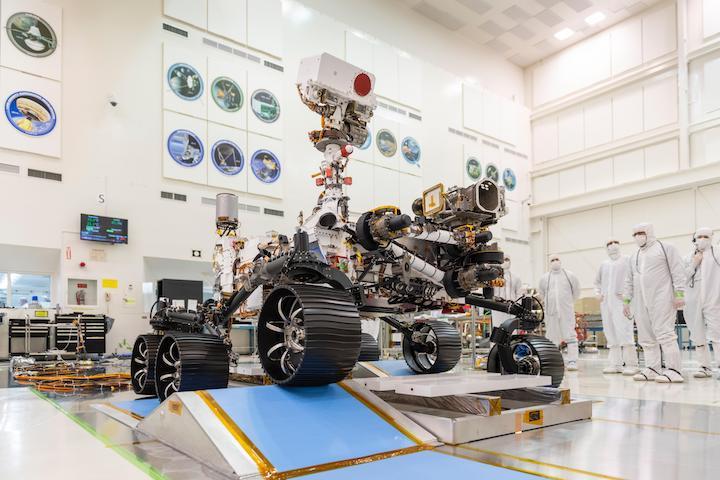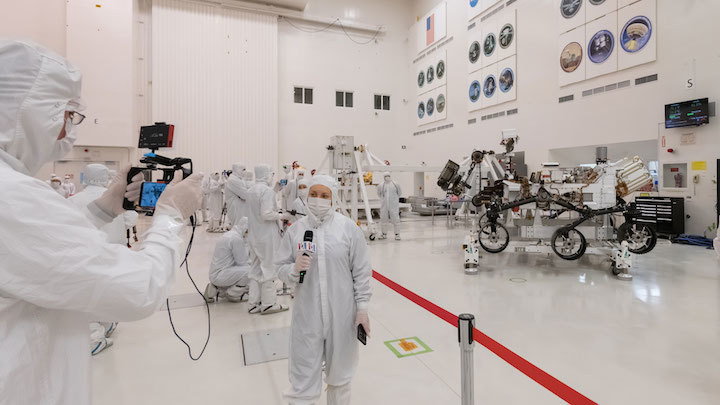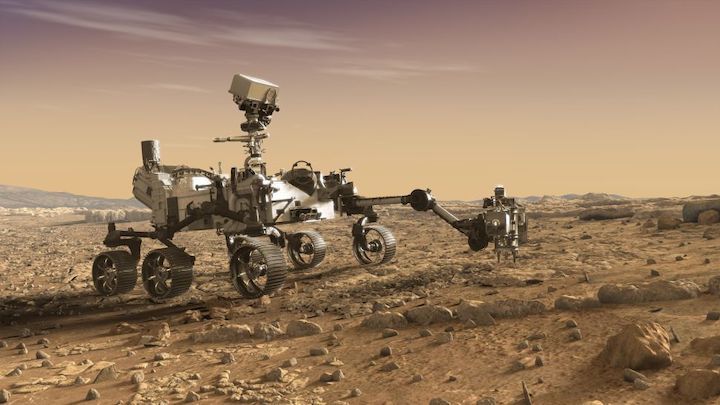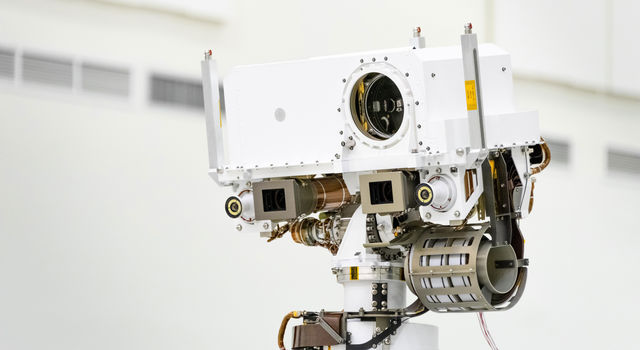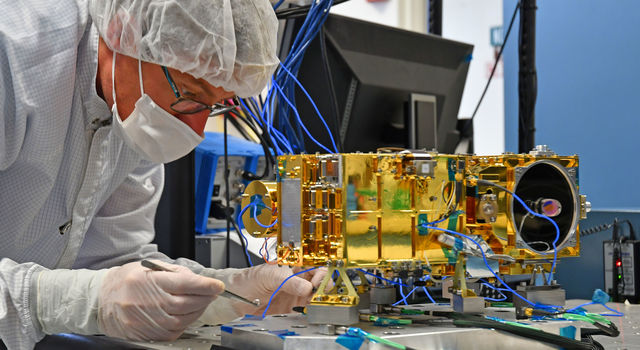12.09.2019
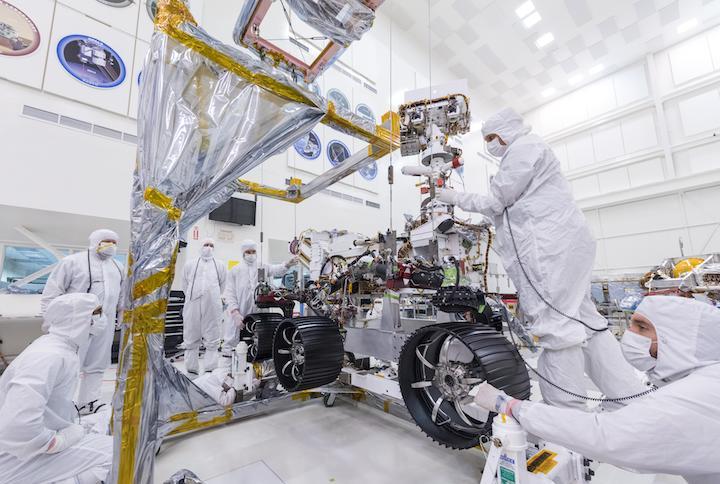
NASA's Mars 2020 Comes Full Circle
Engineers took NASA's Mars 2020 for a spin on Aug. 29, 2019. The 2,300-pound (1,040-kilogram) Martian vehicle was rotated clockwise and counterclockwise at about 1 revolution per minute on what is called a spin table in the clean room of the Spacecraft Assembly Facility at NASA's Jet Propulsion Laboratory in Pasadena, California. (The rotation was speeded up in the video above.) The engineers were looking for the rover's center of gravity, or the point at which weight is evenly dispersed on all sides.
Establishing the rover's center of gravity is a key part of the assembly process and helps ensure that the spacecraft travels smoothly from launch to entry, descent and landing on Mars as calculated. Engineers can add weights in order to help balance out the vehicle. In the end, they affixed nine tungsten weights totaling 44 pounds (20 kilograms) to the rover chassis at predetermined attachment points to get the center of gravity just right.
"The spin table process is similar to how a gas station would balance a new tire before putting it on your car," said Lemil Cordero, Mars 2020 mass properties engineer at JPL. "We rotate the rover back and forth and look for asymmetries in its mass distribution. Then, similar to your gas station putting small weights on the tire's rim to bring it into balance, we'll put small balance masses on the rover in specific locations to get its center of gravity exactly where we want it."
This was the assembled rover's first spin table test to determine its center of gravity; a second and final spin table test will occur at a NASA facility at Cape Canaveral in Florida next spring.
JPL is building and will manage operations of the Mars 2020 rover for NASA. The rover will launch on a United Launch Alliance Atlas V rocket in July 2020 from Space Launch Complex 41 at Cape Canaveral. NASA's Launch Services Program, based at the agency's Kennedy Space Center in Florida, is responsible for launch management.
When the rover lands at Jezero Crater on Feb. 18, 2021, it will be the first spacecraft in the history of planetary exploration with the ability to accurately retarget its point of touchdown during the landing sequence.
Charged with returning astronauts to the Moon by 2024, NASA's Artemis lunar exploration plans will establish a sustained human presence on and around the Moon by 2028. We will use what we learn on the Moon to prepare to send astronauts to Mars.
To submit your name to travel to Mars with NASA's 2020 mission and obtain a souvenir boarding pass to the Red Planet, go here by Sept. 30, 2019:
Quelle: NASA
----
Update: 8.10.2019
.
NASA's Mars 2020 Rover Tests Descent-Stage
Separation
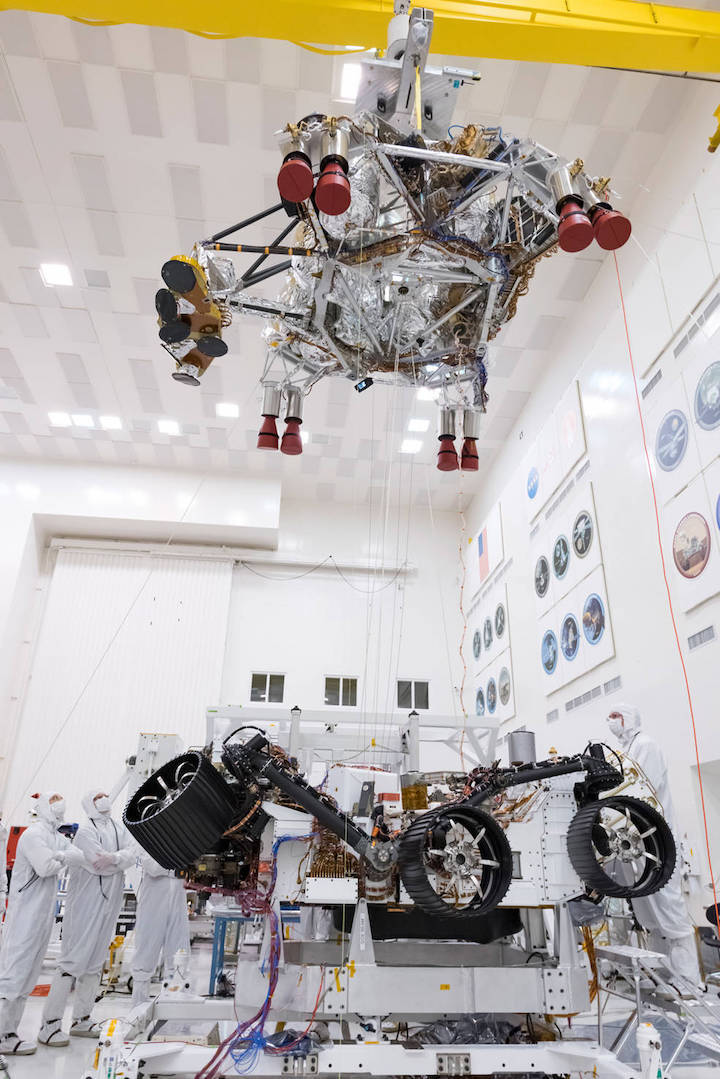
In this picture from Sept. 28, 2019, engineers and technicians working on the assembly and testing of the Mars 2020 spacecraft look on as a crane lifts the rocket-powered descent stage away from the rover. They've just completed a successful separation test at NASA's Jet Propulsion Laboratory in Pasadena, California.
"Firing the pyrotechnic devices that held the rover and descent stage together and then doing the post-test inspection of the two vehicles was an all-day affair," said Ryan van Schilifgaarde, a support engineer for Mars 2020 assembly at JPL. "With this test behind us, the rover and descent stage go their separate ways for a while. Next time they are attached will be at the Cape next spring during final assembly."
Both the rover and descent stage will ship to Cape Canaveral, Florida, this winter. Before then there'll be a battery of tests for the Mars 2020 rover, including an evaluation of its computers and mechanical systems in Mars-like conditions. Called the Surface Thermal Test, it involves subjecting the car-size Mars vehicle to atmospheric pressures and temperatures similar to those it will encounter on the Red Planet.
JPL is building and will manage operations of the Mars 2020 rover for NASA. The rover will launch on a United Launch Alliance Atlas V rocket in July 2020 from Space Launch Complex 41 at Cape Canaveral Air Force Station. NASA's Launch Services Program, based at the agency's Kennedy Space Center in Florida, is responsible for launch management.
When the rover lands at Jezero Crater on Feb. 18, 2021, it will be the first spacecraft in the history of planetary exploration with the ability to accurately retarget its point of touchdown during the landing sequence.
Charged with returning astronauts to the Moon by 2024, NASA's Artemis lunar exploration plans will establish a sustained human presence on and around the Moon by 2028. We will use what we learn on the Moon to prepare to send astronauts to Mars.
Interested K-12 students in U.S. public, private and home schools can enter the Mars 2020 Name the Rover essay contest. One grand prize winner will name the rover and be invited to see the spacecraft launch in July 2020 from Cape Canaveral.
Quelle: NASA
----
Update: 29.10.2019
.
This time-lapse video, taken on Oct. 8, 2019, at NASA's Jet Propulsion Laboratory in Pasadena, California, captures the first time NASA's Mars 2020 rover has carried its full weight on its legs and wheels.
"After years of design, analysis and testing, it is fantastic to see the rover on her wheels for the first time," said Ben Riggs, a mechanical systems engineer working on Mars 2020 at JPL. "The whole team looks forward to seeing her in the same configuration on Mars in the not too distant future."
The rover's legs (the black tubing visible above the wheels) are composed of titanium, while the wheels are made of aluminum. Measuring 20.7 inches (52.5 centimeters) in diameter and machined with traction-providing cleats, or grousers, the wheels are engineering models that will be replaced with flight models next year. Every wheel has its own motor. The two front and two rear wheels also have individual steering motors that enable the vehicle to turn a full 360 degrees in place.
When driving over uneven terrain, the rover's "rocker-bogie" suspension system — called that because of its multiple pivot points and struts — maintains a relatively constant weight on each wheel for stability. Rover drivers avoid terrain that would cause the vehicle to tilt more than 30 degrees, but even so, the rover can handle a 45-degree tilt in any direction without tipping over. It can also roll over obstacles and through depressions the size of its wheels.
The Mars 2020 rover was photographed in the Simulator Building at JPL, where it underwent weeks of testing, including an extensive evaluation of how its instruments, systems and subsystems operate in the frigid, near-vacuum environment it will face on Mars.
JPL is building and will manage operations of the Mars 2020 rover for NASA. The rover will launch on a United Launch Alliance Atlas V rocket in July 2020 from Space Launch Complex 41 at Cape Canaveral Air Force Station. NASA's Launch Services Program, based at the agency's Kennedy Space Center in Florida, is responsible for launch management.
When the rover lands at Jezero Crater on Feb. 18, 2021, it will be the first spacecraft in the history of planetary exploration with the ability to accurately retarget its point of touchdown during the landing sequence.
Charged with returning astronauts to the Moon by 2024, NASA's Artemis lunar exploration plans will establish a sustained human presence on and around the Moon by 2028. We will use what we learn on the Moon to prepare to send astronauts to Mars.
Interested K-12 students in U.S. public, private and home schools have one more week to enter the Mars 2020 Name the Rover essay contest. One grand prize winner will name the rover. The contest closes Nov. 1, 2019.
Quelle: NASA
----
Update: 16.12.2019
.
Lockheed Martin Delivers Mars 2020 Rover Aeroshell To Launch Site
The capsule-shaped aeroshell that will protect NASA's Mars 2020 rover was delivered to NASA's Kennedy Space Center, Florida. yesterday. Built by Lockheed Martin [NYSE: LMT], the aeroshell will encapsulate and protect the Mars 2020 rover during its deep space cruise to Mars, and from the intense heat as the entry system descends through the Martian atmosphere to the surface of Mars.
Because of the large mass and unique entry trajectory profile that could create external temperatures up to 3,800 degrees Fahrenheit, the heat shield uses a tiled Phenolic Impregnated Carbon Ablator (PICA) thermal protection system instead of the Mars heritage Super Lightweight Ablator (SLA) 561V. This will only be the second time PICA has flown on a Mars mission.

"Even though we have the experience of building the nearly identical aeroshell for the Curiosity Rover, the almost 15-foot diameter composite structure was just as big a challenge to build and test 10 years later," said Neil Tice, Mars 2020 aeroshell program manager at Lockheed Martin Space. "We've built every Mars aeroshell entry system for NASA of its 40 years of exploring Mars, so we pulled from that experience to build this important system."
Along with the Curiosity mission, this is the largest aeroshell/heat shield ever built for a planetary mission at 4.5 meters (nearly 15 feet) in diameter. In contrast, the aeroshell/heat shield of the InSight lander measured 8.6 feet and Apollo capsule heat shields measured just less than 13 feet.
The backshell and heat shield were transported from Lockheed Martin's Waterton facility in Littleton, Colorado where they were built, to nearby Buckley Air Force Base. They were then loaded onto an Air Force transport plane and flown to NASA's Kennedy Space Center.
Recently, Lockheed Martin integrated the MSL Entry Descent and Landing Instrument (MEDLI2) onto the heat shield and backshell. Provided by NASA's Langley and Ames Research Centers, MEDLI2 will collect temperature and pressure data during the spacecraft's descent through the Martian atmosphere.
The Mars 2020 rover is in testing at NASA's Jet Propulsion Laboratory, Pasadena, California., which manages the Mars 2020 project for the NASA Science Mission Directorate, Washington. The mission will launch in July 2020 and land on Mars in February 2021 at the Jezero Crater.
Quelle: Lockheed Martin
----
Update: 19.12.2019
.
NASA's Mars 2020 Rover Completes Its First Drive



